Tomales Bay Explorers Club 2001
||photos||
Black Rock Desert Playa - May

Scouting out a Fourth of July campsite in May for a group of friends, combined with a trip to the Burning Man storage site north of Gerlach, I stopped at the Texaco in Gerlach to gas up one last time. "Pretty dry year, Bill?" "Yup, pretty dry, not much rain this winter." And it was pretty much the same in July and August. Will told me the crust was due to "frost bloom". The moisture at the ground surface early in the year freezes and fluffs up the silty clay of the playa, and it takes a good rain or flooding from the Quinn River later in the spring to settle the crusty ground. Didn't happen, and the one- to three-inch-thick dusty crust present over most of the Black Rock early in the summer persisted through August.
Noman - July
Resistance Is Futeless! - Photographer Fatwah
A cartoon feature dedicated to involuntary photographer subjects everywhere.
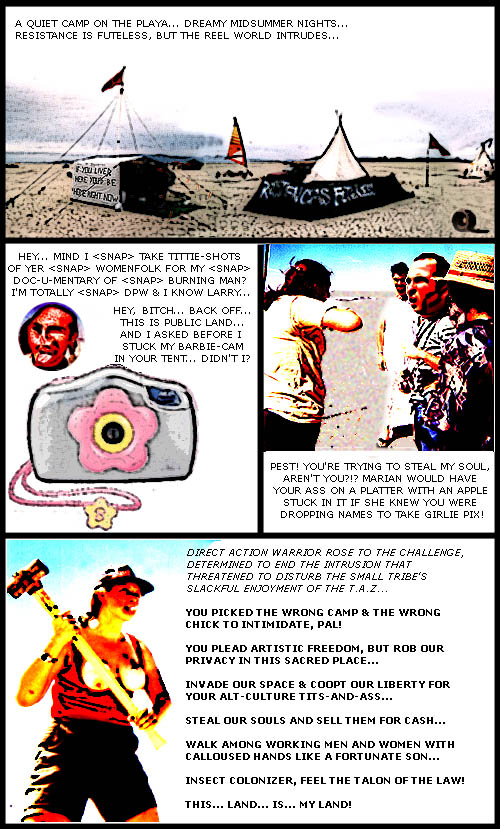
Site Crew (DPW) - Burning Man - July and August
Been an interesting year. People worked, fought, went native, went AWOL, quit, got evicted, died, born, and returned to ask forgiveness and absolution. Tough year. Exhausting year. Great year. Beautiful year. Painful year.
I've built things at Burning Man since the Free Mass Shower in 1996, and the Cafe in 1997 and 1998. For a frame of reference, the Cafe in 1997 was the same size as either the Playa Info Services or Black Rock Gazette in 2001. I answer questions from theme campers, artists, and other participants on building adequate structures for the desert conditions, and work with the site crew as a carpenter and construction manager. My name appears on two or three Burning Man org charts (yes, Virginia, they have org charts), and I'm aliased two Burning Man email addresses. In 2000 and 2001 Burning Man has paid me a stipend for carpentry and construction supervision onsite. This year and previous years I've volunteered year-round for construction designs and estimates, carpentry, content and design for my own and the Burning Man websites, construction and burn scar prevention input for theme camps and art installations, DPW liason tasks with other Burning Man department staff, loading and driving trucks, cleanup, and a number of things that escape me or I'd rather forget.
All the internal nagging melted away as soon as I crested the hills above Empire on my return to the ranch on an early August evening. Dark groups of clouds lumbered across the sky, dropping lightning bolts across the broad stretch of the Black Rock playa, and the road between Empire and Fly Ranch was wet from the recent rain. The ground sprang forth with the characteristic odor of moisture hydrating the oils released by the desert plants. We heard from Alan by radio from Frog Pond that lightning fires had started nearby, and he spent that night and the following morning chasing them down with heavy equipment. The little rain that fell did almost nothing to settle the dusty surface of the playa. You could say it was a drought year, in an area that only gets about eight inches of rain annually.
We had great crew people, finished almost everything we started, and nothing blew down. My crews built about thirty shade structures and did accessory carpentry (benches and tables) for Burning Man staff this year. Having the new property and setting up a shop made a huge difference. We owe a debt to Will Roger, Flynn Mauthe, the Workman family of heavy equipment operators, and the rest of the ranch crew for their enormous efforts, and the Black Rock City LLC for their foresight in purchasing the new property.
The site crew (DPW) this year had a core of people who've been through the drill since 1997 and 1998, with an overabundance of great volunteers and staff who rode blithely (or blindly) along with us on the usual dusty hell-ride. It was a great feeling -- it gives me pride in community to work beside such gritty, open, strong, enthusiastic, giving people. Thanks so much, all of you!
It's About Survival
Burning Man staff people -- about building your infrastructure. Let's have a little talk.
At the end of the event, one of you said to me over the radio, "Don't tell me how to do my job."
Good! That's exactly what I want to hear.
Once upon a time, each Burning Man staff group that needed shade structures or kitchens or tables just did it themselves. What's so different now?
Okay, so DPW made it look as if they were going to do everything for ya'll? Not so. When we asked for at least two or three volunteers from each group with shade structures to build, we didn't expect only a single person showing up on the last weekend, trying to use a clipboard for a hammer, who has ten dozen other things to do. No, no, sister. That ain't a way to camp.
Okay, so we also had a flaw in the concept of "volunteers." Assigning DPW volunteers from DPW volunteer rolls to build your campsite is not what we had in mind. You have volunteer coordinators. Look through your own volunteer database and find a few people to build your camp. Simple. Make sure they show up. Let DPW know if you need instructions.
Okay, so building shade structures looks like rocket science? Not so -- they go together like tinker toys. Holes in the ground, posts, plywood gussets, beams, shade cloth, done. Very simple. And fun. You'll get a tan. You'll lose some of that paunchy belly. Yes, you with that roof over your tools. You, in that tent dress.
Okay, so I myself pushed for lots of shade and building whatever else for the volunteer groups who show up at the event. But the last thing I ever wanted to do with all this new building is erode people's initiative and survival instincts.
I'm proud we have groups such as the Greeters and Earth Guardians who insist on building and maintaining their own facilities. This year and last, both had volunteers coming out in May or July or early August to check their inventories stored at the 80 Acres, fix what might be broken, and to build any new items they needed. The Gate, Rangers, Gazette, and Lamplighters provided lots of help with their facilities. But I wish more of you were like the Greeters, who just tell us: "Don't call us, we'll call you, buddy!"
A camp is a camp is a camp. If you organize your camp as such, from conception to staffing to setup and breakdown, you'll be as self-sufficient as Burning Man councils its participants' camps to be. Make sure you have people on your staff who can swing a hammer. Bring a ladder. Bring a truck. Carry your own water and wood. Take pride in what you do, and set a good example. Be a scout.
Go up and visit your shade structure in July, if not March or May or October. Give it a nice new coat of paint. The ranch has a lovely little campground.
Planning & Departments
This is how I explained it to someone: Four hundred theme camps is a round figure. It was the approximate number of registered (via the online database thingie) and placed (actually mapped) theme camps we had last year, but I never got a final count this year because of last minute Filemaker Mac/PC and mapping program fuckups, but I'm guessing up to a couple hundred were registered and placed, some not, and a few dozen Jo Blows with scaffold, a parasol, and a beer cooler; the system hinges on self-reporting, so we get anything from literal napkin sketches to 3-D renderings to Autocad drawings to 8x10 color glossy photographs with circles and arrows and a paragraph on the back of each one explaining what each one was to be used as evidence against us, with pictures of the approach, the getaway, the northwest corner, the southwest corner, and that's not to mention the aerial photography, to Web sites that sometimes have nice orderly navigation and some not and some are passworded and they don't bother to tell you and some never get finished, and more often than not you just get plain nothing, and not everybody builds what they plan, or plans what they build, and if you work with DPW as well as the theme camp crew, as some of us brave souls do, you leave town for the desert before the final theme camp mapping is done, and if you're out of sight of the people in the SF office, you're out of mind, despite the fact that logically speaking you should be one of the more important end-users, so you aren't provided with a final theme camp map product from either the theme camp people or the techie map person based somewhere near Boulder, Colorado, and all these people barely speak to each other anyway, so you can't plan ahead as you anticipated with your own database of mapped theme camps, structure types, and their street addresses, so it inevitably requires just trying to inform people as best as you can via a few Web links mailed out with the periodic theme camp mailings, so on the ground you're dealing with some people you can trust implicitly with building something that will stand up, people with a combination of experience on the playa and an aggregate of carpentry and rigging and native or formal engineering skills, or just a bunch of regular folk, and you just try to keep that in mind, and when the event actually starts up, which varies for some theme camps from a week before the event if they're also volunteering with the site crew to the actual date on the ticket, just keeping as many eyes open as you can over the entire week before and the week of the event as people put up their hundreds of camps, whether in the more limited "mapped" theme camp zone this year or not, not to mention the art installations for which you also were expecting to get 8x10 color glossy photographs with circles and arrows and a paragraph on the back of each one explaining what each one was to be used as evidence against us, with pictures of the approach, the getaway, the northwest corner, the southwest corner, and that's not to mention the aerial photography, and also not to mention the GPS coordinates that the geek in Colorado and the theme camp people and the art installation people and the still-born Planning Department were expecting to have in hand before the event, but as it turned out your Handspring Visor with Filemaker Mobile installed and its nifty Magellan GPS unit turned out to be incompatible with the Garmin-based unit the geek in Colorado so thoughtfully provided with a brain-dead DOS-based input system.
Make sense? You just deal with it asbestos you can.
Monumental Triumphs & Mistakes
This year's elevated wooden pedestal structure for the Man, designed by Rod Garrett, who is also responsible for the physical plan of Black Rock City, was an absolutely magnificent departure from past years. The city has grown large, and deserves a monumental focal point. The Man, teetering first on bare ground in the early years, then rising tentatively to its perch on a small pile of straw bales, has served as that focus throughout the history of the event. Larry Harvey should treat very seriously the making of an architectural wonder as the seat of the wooden effigy he himself invented, with the reverence and eye to historical and cultural cues it truly deserves. Make this one art installation rival a Mayan temple complex, a gothic cathedral, and the very mountains themselves, and you will have a monument that I, for one, would be happy to help build and burn.
The criticism of some that there is too much monumental art at Burning Man and that the whole place has turned into some sort of Disneyland seems a bit puritanical to me. The Man itself is an eloquent argument in favor of monumental art. The Temple of Tears this year may have been the biggest structure ever built for burning at the event, but I have yet to hear anyone criticize it. Helco was one of my favorite burns. Of course, there may be tolerable limits on size, but I have different concerns.
The "keyway" -- the central-axis wedge as viewed from Center Camp toward the Man, framed by the vacant desert beyond -- in past years presented a magnificent view, free of obstructions. A person taking a first exploratory walk around camp would find the Promenade, the lantern-lined processional path leading from Center Camp to the focal point of the City, and see ahead the classic vista of a vague anthropomorphic figure rising above the desert expanse, between the double row of elegant lantern spires; then the emerging visage of the Man, standing alone, body rigid, with a symmetrical head that could be facing any compass direction -- northeast, into the unpopulated desert, looking for the last wild places? -- or southwest, back home to its birth place on the ocean beaches of San Francisco? In one instant the Man might represent everything to which the human spirit aspires; a moment later representing nothing but a few artfully-placed sticks of wood awaiting the proper dose of accelerant and fire; in another microsecond the image of one's mother or father or teacher or lover or lost friend, appearing starkly out of the haze of a waking dream; or simply a geometric abstraction, a three-dimensional puzzle, an elaborate Japanese kite frame.
For me, such musings are greatly impeded, now that the keyway is cluttered with a haphazard jumble of art installations, with the Man popping out of the mess like a petrified prairie dog.
In the last two years, a select number of the "theme art" installations have been placed in the area immediately around the Man, or along the Promenade alignment. Again, I have no problem with the art installations themselves, their size, or their cost. I just think the keyway ought to be cleared out for simple esthetic reasons, and because of another disturbing aspect that has to do with fairness, honesty, and democracy.
The concept of "theme" is used in two senses at Burning Man. "Theme camps" began with Xmas Camp in 1993, transforming over the years from a vague, irreverent template for creative camping to an institution supported by an entire Burning Man organizational department, geared to helping participants create something other than your normal drive-in campground.
In the second sense, beginning in 1997, the annual "theme" for Burning Man has been chosen and defined by Larry Harvey, in concert with other people involved in encouraging art at the event, to establish a common reference point for artists, theme campers, and performers to key their creative efforts. No one is required to "theme" in any rigid sense, or "theme" at all, but it is apparent that proposals for art installations keyed to the theme have received more backing and publicity from the Burning Man organization, and "theme art" has evolved as an institution.
The problem for me is this -- the cluster of "theme art" around the Man has in essence become a theme camp the size and scale of which no private, unfunded, participants' theme camp could hope to approach, and is in actuality a misappropriation of the theme camp concept. It's now known as "Larry's Theme Camp" among many at Burning Man. It garners an unfair amount of prominence by comparison with other participants' art installations or theme camps by virtue of its rather deafeningly loud sponsorship by the Burning Man organization, its placement in the centermost location in Black Rock City, and its advertisement on the Burning Man website and in all Burning Man publications; all at the literal expense of the mass of Burning Man participants. Theme camps are traditionally by, for, and about average Burning Man participants, who come with ideas and materials eked out of their own sweat and pocketbooks. That this would be appropriated by the Burning Man art officialdom is perhaps flattering, but in a greater sense is intimidating and undemocratic.
The "passport" plan this year gave the appearance of instituting a mediated, overly-procedural gating of the official Burning Man theme art enclave. The Man's pedestal was incorporated as part of the Seven Ages theme art as the Temple of Wisdom, and completion of a ritual was required to gain access to the interior and upper levels of the pedestal structure. Similar procedures were required at the other official theme art installations. Passports and passport stamps were an idea borrowed with tacit permission from the Artists Republic of Fremont, a Seattle-based theme camp which in 1998 encouraged other Burning Man theme camps to make their own passport stamps and invent rituals for participants to gain the stamp. While the official intent this year may have been to encourage more of a sense of participation with the theme art, in my opinion the official sponsorship, and the crowding of select art installations in the central area around the Man, gave the appearance of the Burning Man organization going over the top with attempting to mediate people's experience at what is otherwise mandated as a participant-created event.
The esthetics of the Man's pedestal were much-debated among participants throughout the year 2001. The pedestal was increased from about 14 feet to 30 feet in height from the previous year, and faced with plywood rather than straw bales. Many people this year expressed regret at being prevented intimate contact with the Man, especially in the ritualistic raising and lowering done by volunteers in previous years, in which dozens would be called to the center of the city to strain on a heavy rope attached to the Man. This year the Man was raised by a DPW rigging crew with the assistance of a crane. The Man was fixed in place, rather than being hinged at the base of the legs. Although with the new configuration we now have the real benefit of more stability and less potential for damage, it is a significant parting with the past.
I think the design succeeded magificently, and did not, as some have said, make the Man too lofty or completely inaccessible. But the base could be a much more of a comfortable place to ponder the wide sweep of the city. As Bruce Sterling wrote for Wired Magazine,
The Burning Man is good art. Flat on his back, he looks like a giant abandoned packing crate, but when he's catapulted into standing position, he becomes a striking neon symbol of pretty much everything that matters. You can sit on a hay bale at the foot of the Burning Man and the whole world passes by. It's like hanging out on the Venetian Rialto.
We shouldn't suppress changes and new ideas at Burning Man, but should be much more careful about changes that have the potential to alienate and divorce us from the ideals and independent people who contribute things small and large to the event. This requires attention to mitigating the not-so-subtle messages sent by making changes such as closing off access to the foot of the Man, or not making the pedestal a more hospitable place to sit and take in the view. Going with a main theme chosen by our esteemed founder and encouraging efforts small and large that key off that theme is one thing; institutionalizing a juggernaut of a theme-camp-like aggregation of art installations squatting in the center of Black Rock City and dominating all official Burning Man media is malodorously monopolistic.
Let Theme Camps be Theme Camps, and Free the Man!
Those who miss yanking on the Man's rope can certainly volunteer for many other things. Every year we do something different. Change is good.
Photos from the Work Ranch & Burning Man 2001
Flynn
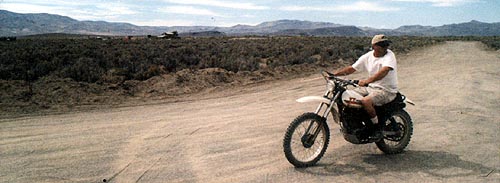
Dust Devil over the old shop
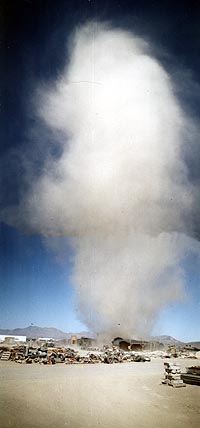
Tanks
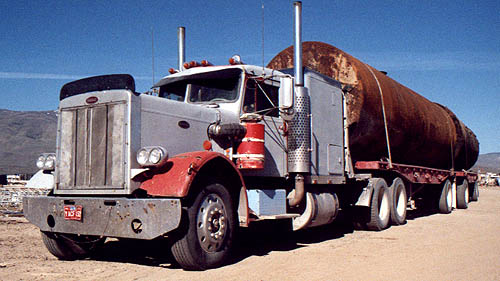
Work Ranch carpentry shop under construction - early July 2001

Work Ranch production - August 2001 - two weeks before the event
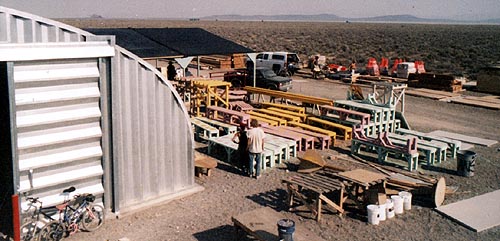
Construction/Shade Crew - one week before the event
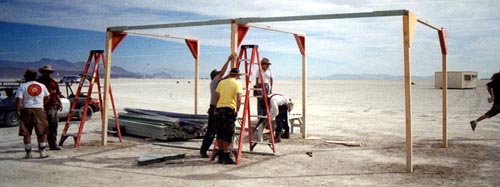
Girlie Man - made by Andrew - fire by Aaron
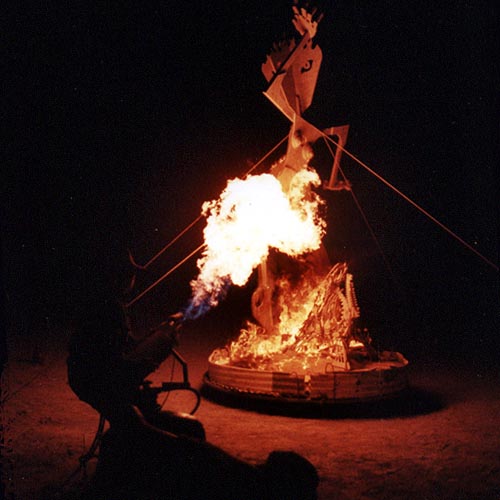
Gate Kiosk Cadillac, by Skitch, Leo & the metal shop crew
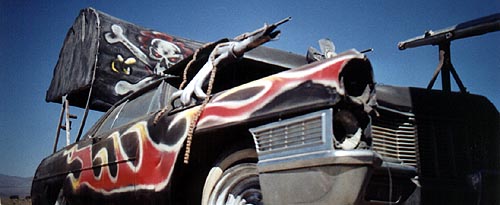
Gate Kiosk Pinto
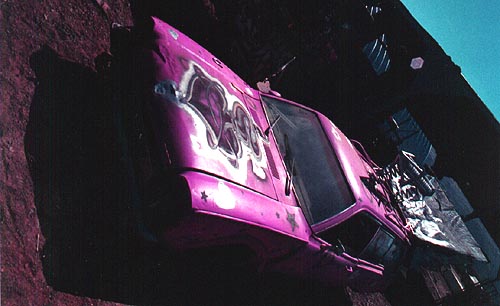
DPW Depot
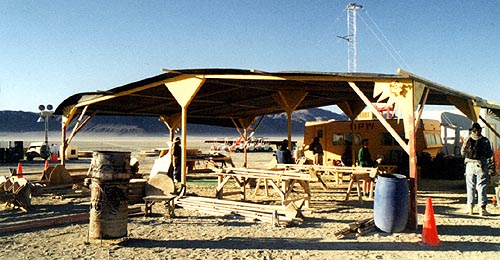
Raising the Man - Randy about to foot the feet
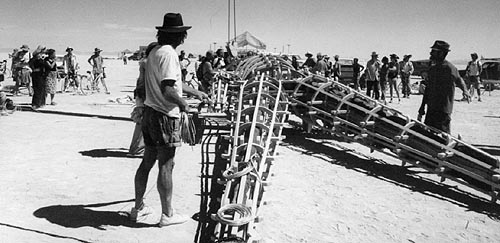
Zsuzsa & Davis on the ropes, Russ and Andrew up top
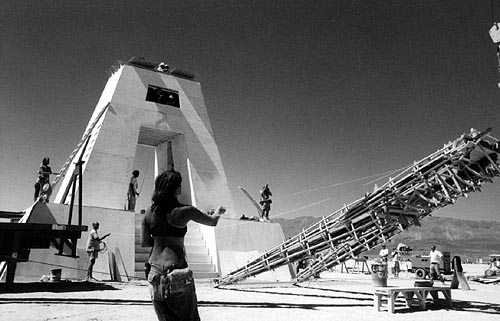
Creaking upward
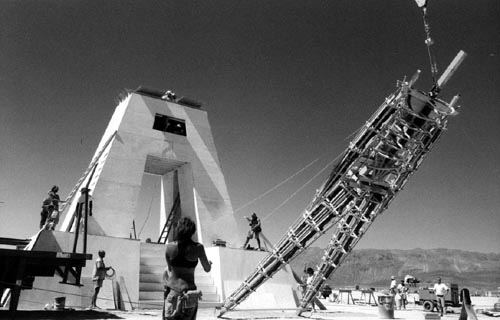
A well-hung Man
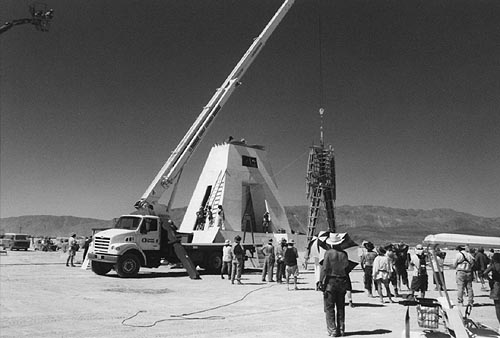
Steady as he goes
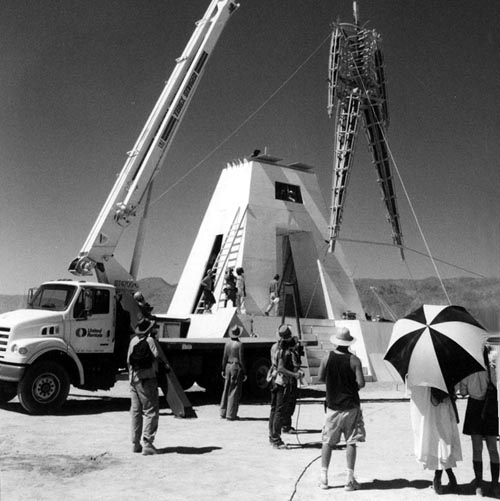
Bolted at top & ready to set the guy cables
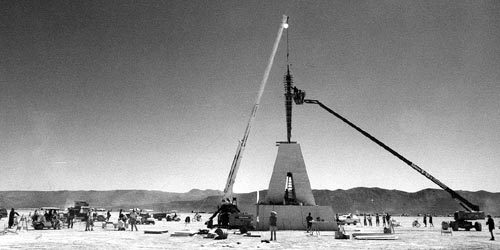
Tim & Simon applying some riggerology
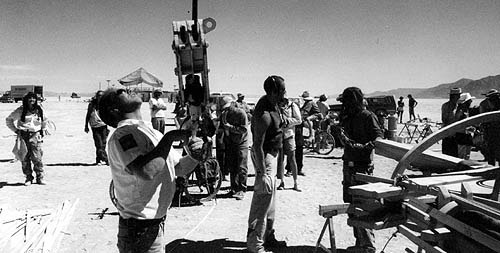
Dale & Michael in the lift - Spyral, Andrew, & Russ - Rivka & The Man

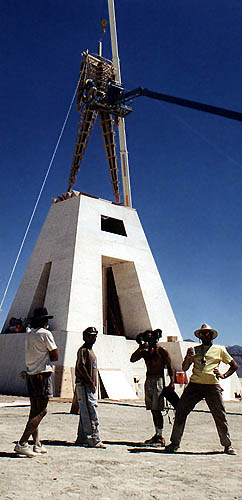

Bob

Annual photo of Michael Christian on a ladder, finishing "Flock"

Cornfield

by Sun Brothers; also see cornfield pix
Fan - Lantern

aka La Rificolona
Emotional Baggage Check

3D Camera Obscura - Fiat Lex
Camp tent

3D Camera Obscura and camp crew

Annalisa at the Mausoleum, under construction

The Burn

Mausoleum in white-out

Mausoleum after the burn

© Bob Stahl | Home